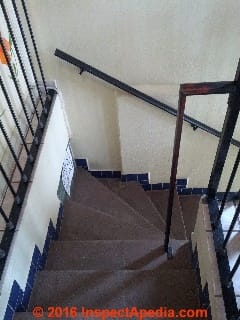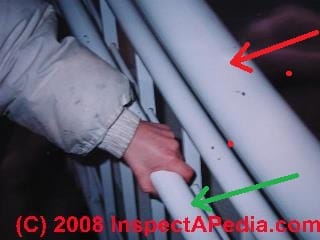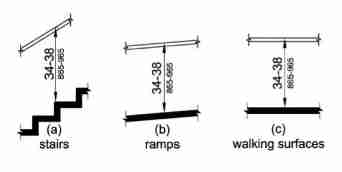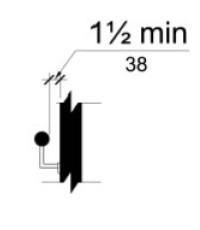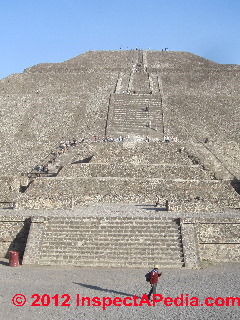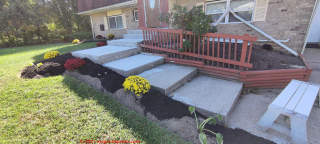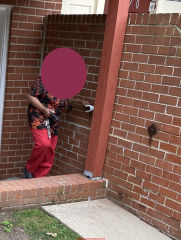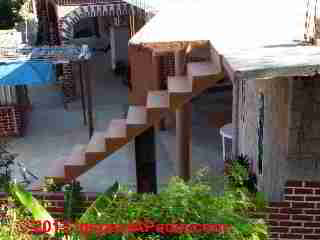 Building Handrailing Code Specifications & OSHA Stair Codes
Building Handrailing Code Specifications & OSHA Stair Codes
Model building codes specify handrailing construction
- POST a QUESTION or COMMENT on code requirements for building and installing stair railings and guard rails and stair/railing safety & regulations
Handrails & handrailings codes for stairs, steps, & other locations:
This article provides example & specific stair rail construction & installation specifications & building code citation for handrailings used in or at buildings on stairs and at other walking surfaces where handrails are needed.
This article series explains and illustrate the requirements for graspable handrails & railings used inside or outside buildings, including guardrails, hand railings on steps and stairs, and stair rails or stair guards for both interior and exterior stairways. used on stairs, balconies, decks, ramps, walks.
We include descriptions & definitions of graspability for handrailings, and we illustrate safe and unsafe, graspable and not-graspable handrailings in sketches, photographs, and building code citations.
These stair and railing articles provide building code specifications, sketches, photographs, and examples of stair & railing safety defects used in inspecting indoor or outdoor stair railings or handrails and related conditions for safety and proper construction. Our page top photo illustrates an open, exterior stair at La Huerta, Guanajuato, Mexico.
InspectAPedia tolerates no conflicts of interest. We have no relationship with advertisers, products, or services discussed at this website.
- Daniel Friedman, Publisher/Editor/Author - See WHO ARE WE?
Handrail Specifications & Defects: requirements for handrailings along stairs & other locations

This article explains and illustrate the requirements for safe, usable hand railings on steps and stairs, both interior and exterior stairways. Handrailings are a critical safety feature on outdoor and indoor stairs, and ramps, as are guardrails along landings, platforms, decks, porches, and similar structures.
[Click to enlarge any image]
At above or left the "handrailing" was filled with running water when we photographed it at el Alhambra in Granada, Spain. This is not a particularly easy rail to grasp if one is falling down the slippery brick stairs.
When Are Handrails Required? How many steps, what total rise height requires a handrail?
The final authority on when and where railings are required on steps, stairs, landings, balconies and decks, rests with your local building code official.
The building code requirement for stair railings typically requires handrailings on stairs that have a total rise of three feet or more. Certainly the stairway that we observed in La Huerta, Mexico (photo at left) as well as the rooftop deck do not meet current safety standards.
- Hand Railing spaced from wall: (=> 1.5" )
- Hand Railing projection into stairs (<= 4.5")
- Hand Railing heights: U.S. principal height standard: handrails at open stairs: 34-38" above the stairs
- Hand Railing height (=> 31.5" one-side-rail, or => 27" with rails on two sides) (Note: this is a "grandfathered" or historic height that local officials may still permit for historic or old buildings)
- Hand Railing heights: U.S. handrails for stairs with one side against a wall: 30-38" (local code official is final authority)
- Hand Railing heights: Canada: Canadian stair handrails: 32-36" above the stairs
- Handrail continuity: handrails should be continuous - that is a hand can slide along the rail without interruption from above the top riser to above the bottom riser; handrails can be interrupted at a newel post at the ends of the stairway.
Also see NEWEL POST CONSTRUCTION.
Reader Question: Is it "legal" for a basement stair to have no handrailing?
I am purchasing a condo and there is no handrail on the stairs leading to the basement. there is a wall on the left and no handrail on the right. is this legal in new york state, and or nassau county? thank you for you assistance, S.F. 7/26/12
Reply: No, not normally
Our photo (at left) shows a common but unsafe lower floor or basement stair condition in an older home.
This stair is missing both handrailings and a stair rail or stair guard along the stair open side.
To make it possible to move large furniture or other objects between floors someone has removed the handrail and balusters that were originally installed on the open side of this stairway. We are sure that a stair rail was originally in place because we see the bottom newel post in our photo.
This is an unsafe stairway - the rail and balusters should be replaced.
If the stair is more than three feet wide (probably it's not), and for all stairs in some jurisdictions, a handrail may also be required along the wall.
The "legality" of this or any other building condition is in the final hands of the local building code department and officials.
Watch out: sometimes a local building department or official will issue a certificate of occupancy or "CO" on a building with conditions like the one shown here, either because the site was not actually visited (instead the "CO" indicates that there were "no issues on file") or because the official just didn't notice or didn't recognize an improper or unsafe condition.
Nevertheless, a "CO" does not prevent accidents nor litigation. "Saying it's OK" doesn't make it "OK" if an unsafe condition exists, and if there is an injury the building department is not going to pay the injured person's medical bills.
For more details about balusters (vertical spindles in railing construction)
see BALUSTERS, STAIR & RAILING CODES for full details of this topic and also
see GUARDRAIL CODES & STANDARDS (railings on landings and open hallways, porches, screened porches, balconies that are more than 30" above floors or grade)
Handrailing Building Codes, OSHA's & Other Codes' Handrailing requirements
Our photo illustrates a handrail that is indeed "graspable"
OSHA requires these handrailing details
- Handrails must provide an adequate handhold for employees to grasp to prevent falls.
- Handrails and top rails of the stair rail systems must be able to withstand, without failure, least 200 pounds (890 n) of weight applied within 2 inches (5 cm) of the top edge in any downward or outward direction, at any point along the top edge.
- Handrails must not be more than 37 inches (94 cm) high nor less than 30 inches (76 cm) from the upper surface of the handrail to the surface of the tread.
- Temporary handrails must have a minimum clearance of 3 inches (8 cm) between the handrail and walls, stair rail systems and other objects.
- Stairways with four or more risers, or that rise more than 30 inches (76 cm) in height- whichever is less- must have at least one handrail.
- Winding or spiral stairways must have a handrail to prevent use of areas where the tread width is less than 6 inches (15 cm). We illustrate this feature in the photo just below.
Above, installed in a restaurant in San Miguel de Allende, Guanajuato, this stair railing includes a grab rail designed also to block the use of the too-small insider corner of the triangular stair treads just below.
In particular the vertical grab bar blocks the unsafe tread area when people are descending the stair.
CA & OSHA Codes for [Graspable] Handrails Along Stairs & for Stair Rails Along Open Stairways as Guards
Details about handrailing graspability are discussed separately
at GRASPABILITY of HANDRAILINGS. Excerpts are below.
Some codes (CA/OSHA Title 8 Section 1626) may cause a little confusion between the definition of handrail (green arrow) and guardrail, by adding a third term, stair rail (red arrow).
A stair rail is basically a guard rail along an open stairway. A stair rail may itself be graspable and serve as a handrailing, or the stair rail might be higher, larger, and not-graspable, as shown in our photo at left. [When these stairs were first constructed, the handrail was not present.]
The following requirements apply to all stairways as indicated:
1926.1052(c)(1) Stairways having four or more risers or rising more than 30 inches (76 cm), whichever is less, shall be equipped with:
(A) At least one handrail; and
(B) A stair rail consisting of a top rail and mid-rail along each unprotected side or edge.
This separation of handrail from stair rail appears intended to permit the construction of the equivalent of a "guardrailing" along open stairways and consisting of not just the horizontal members described in (B) above.
But along an open stairway there will also be a requirement for vertical balusters or other means of enclosing the open or unprotected side or edge. Here "unprotected" side or edge means an "open" stairway - that is, stairs that do not run along an enclosing building wall.
Handrailing Specifications from CA/OSHA Title 8 Section 1626
My photo (left) shows the difficulty of making use of a too-low handrailing when descending a stairway.
Continuing from CA/OSHA Title 8 Section 1626 [paragraph (1) is given and discussed above]:
1926.1052(c)(2) Winding and spiral stairways shall be equipped with a handrail offset sufficiently to prevent walking on those portions of the stairways where the tread width is less than 6 inches (15 cm).
1926.1052(c)(3) The height of stair rails shall be not less than 34 inches nor more than 38 inches from the upper surface of the stair rail to the surface of the tread, in line with the face of the riser at the forward edge of the tread.
1926.1052(c)(4) Mid-rails shall be located at a height midway between the top edge of the stair rail and the stairway steps.
(A) Screens, mesh, or other material, when used in lieu of mid-rails, shall extend from the top rail to the stairway step, and along the entire opening between top rail supports.
(B) Other structural members, when used, shall be installed such that there are no openings in the stair rail that are more than 18 inches (46 cm) wide.
1926.1052(c)(5) Handrails and the top rails of stair rails shall be capable of withstanding, without failure, a force of at least 200 pounds (890 n) applied within 2 inches (5 cm) of the top edge, in any downward or outward direction, at any point along the top edge.
1926.1052(c)(6) The height of handrails shall be not less than 34 inches nor more than 38 inches from the upper surface of the handrail to the surface of the tread, in line with the face of the riser at the forward edge of the tread.
1926.1052(c)(7) When the top edge of a stair rail also serves as a handrail, the height of the top edge shall be not less than 34 inches nor more than 38 inches from the upper surface of the stair rail to the surface of the tread, in line with the face of the riser at the forward edge of the tread.
1926.1052(c)(8) Stair rails and handrails shall be so surfaced as to prevent injury to employees from punctures or lacerations, and to prevent snagging of clothing.
1926.1052(c)(9) Handrails shall provide an adequate handhold. [This means that handrails must be graspable.]
1926.1052(c)(10) The ends of stair rails, handrails and mid-rails shall be constructed so as not to constitute a projection hazard.
1926.1052(c)(11) Handrails that will not be a permanent part of the structure being built shall have a minimum clearance of 3 inches (8 cm] between the handrail and walls, stairrail systems, and other objects.
Profiles & Dimensions of Graspable vs Non-Graspable Handrailings
Details about the codes for and construction of properly graspable handrails are
at GRASPABILITY of HANDRAILINGS.
Excerpts are just below.

If the horizontal profile of a stairway handrailing is too fat (we give an example below, thumb grooves help but don't eliminate the hazard - for oversized stair rails simply can't be grasped securely.
These two sketches (above and below) are found in the California Building Code for stairs and railings [37].
Type II Residential Handrails - for perimeter larger than 6 1/4"
Some (not all) codes allow handrails that have an overall perimeter greater than 6 1/4", most commonly to permit use of 2x lumber to construct handrails.
However in these larger sizes, the handrail must have a thumb and finger groove; Some older codes may permit the 2x6 handrail profile at far left in the illustration below, but as of 2009 the handrail needs a groove on both sides.
The intent of the finger and thumb groove is to provide equivalent graspability as might be obtained on a round 2-inch handrail. (The 2-inch handrail is allowed by all U.S. building codes.)

Watch out: No model building code and no other building code that we have surveyed permitted 2x6 or even 2x4 handrailings installed "on the flat" as a safe graspable stair handrail system. The two sketches here illustrate graspable (and X'd out non-graspable) handrailing profiles.
Reader Question: is a 2x6 handrailing safe and legal?
I fell using a handrail. It was a 2 by 6 piece of wood. Was this safety railing up to code in 1991? - Anon 8/20/12
Will a 2 by 6 pass code prior to 1991 to use as a safety railing ? - Anon
Reply: What are the Specifications for a Graspable 2x Hand Railing Along a Stair?
Anon, a 2x6 handrailing placed "on flat" and even a 2x4 handrailing in the vertical position if it lacks a thumb-groove (sketch above from the CBC [37] - click to enlarge) is not readily graspable, is not safe, and does not comply with the hand railing maximum perimeter rules in model building codes. Recapping from our article above in which we describe the shape and size parameters for stair handrails:
- Railing grip size and shape: (must be able to be grasped)
- Round rails: between 1.25" and 2" in diameter
- Metal ogee shaped: <= 2.25" across widest dimension
- Wood oblate shaped: <= 2.25" across widest dimension
- Rectangular shaped: perimeter must be between 4" and 6.25"
- Perimeter larger than 6" must have a graspable finger recess (see details at the ASM document link below)
That last item in our bulleted list means that code inspectors may approve a 2x6 or 2x4 hand railing placed in the vertical position (narrow dimension facing up - a width that can be readily grasped during a fall, while on flat it cannot - but the design needs to include a finger recess to permit a secure grip.
Without that finger or thumb recess (seems to me it should be on both sides of the rail) the grasp is not secure.
A Comparison of Building Codes Specifying Hand Railing Requirements
Sample excerpts of sources which a building code compliance inspector would be expected to cite in support of requiring a properly-designed, properly-secured guard rail include but are not limited to the citations below.
Our photo (left) indicates mid-stairway activities that could require secure handrails at a Tango dance hall in Buenos Aires.
International Building Code 2000 (BOCA, ICBO, SBCCI) Handrail Rules
1003.3.3.11.3 Handrail grasp ability.
andrails with a circular cross section shall have an outside diameter of at least 1.25 inches (32 mm) and not greater than 2 inches (51 mm) or shall provide equivalent grasp ability.
If the handrail is not circular, it shall have a perimeter dimension of at least 4 inches (102 mm) and not greater than 6.25 inches (159 mm) with a maximum cross-section dimension of 2.25 inches (57 mm).
Edges shall have a minimum radius of 0.125 inch (3.2 mm).
100333.11.4 Continuity.
Handrail-gripping surfaces shall be continuous, without interruption by newel posts or other obstructions.
1607.7 Loads on Handrails, guards, grab bars and vehicle barriers
1607.7.1.1 Concentrated Load.
Handrail assemblies and guards shall be able to resist a single concentrated load of 200 pounds (0.89kN), applied in any direction at any point along the top, and have attachment devices and supporting structure to transfer this loading to appropriate structural elements of the building.
1607.7.1.2 Components.
Intermediate rails (all those except the handrail), balusters and panel fillers shall be designed to withstand a horizontally applied normal load of 50 pounds (0.22 kN) on an area not to exceed one square foot (305mm2) including openings and space between rails.
BOCA National Property Maintenance Code 1993 Handrailing Requirements
PM-305.5 Stairs and railings:
all interior stairs and railings shall be maintained in sound condition and good repair.
Commentary: Handrails, treads and risers must be structurally sound, firmly attached to the structure, and properly maintained to perform their intended function safely. During an inspection the code official should inspect all stringers, risers, treads, and handrails.
PM-305.6 Handrails and guards:
Every handrail and guard shall be firmly fastened and capable of supporting normally imposed loads and shall be maintained in good condition.
Commentary: This section provides for the safety and maintenance of handrails and guards. See Section PM-702.9 for additional requirements.
PM-702.9 Stairways, handrails and guards:
Every exterior and interior flight of stairs having more than four risers, and every open portion of a stair, landing or balcony which is more than 30 inches (762mm) high, nor more than 42 inches (1067mm) high, measured vertically above the nosing of the tread or above the finished floor of the landing or walking surfaces. Guards shall be not less than 30 inches (762mm) high above the floor of the landing or balcony.
Commentary: Handrails are required on all stairs more than four risers in height. Handrails cannot be less than 30 inches nor more than 42 inches above the nosing of the treads (see Figure PM-702.9).
Guards are required on the open side of stairs and on landings and balconies which are more than 30 inches above the floor or grade below.
The guard must be at least 30 inches above the floor of the landing or balcony.
Guards are to contain intermediate rails, balusters or other construction to reduce the chance of an adult or child from falling through the guard.
If the guard is missing some intermediate rails or balustrades, it is recommended that the guard be repaired to its original condition if it will provide protection equivalent to the protection it provided when originally constructed.
Uniform Building Code Stairway, Railing, & Guardrail Specifications (UBC 10.3.3.36)
Using 1997 UBC version as a model [38]
Stairway Handrail Width Requirements & Codes
The handgrip portion of handrails shall not be less than 1-1/4 inches (32 mm) nor more than 2 inches (51 mm) in cross-sectional dimension or the shape shall provide an equivalent gripping surface.
The handgrip portion of handrails shall have a smooth surface with no sharp corners.
Handrails projecting from a wall shall have a space of not less than 1-1/2” (38 mm) between the wall and the handrail.
Stairway Handrail Height Requirements & Codes
The top of handrails and handrail extensions shall not be placed less than 34” (864 mm) nor more than 38 inches (965 mm) above landings and the nosing of treads.
Handrails shall be continuous the full length of the stairs and at least one handrail shall extend in the direction of the stair run not less than 12 inches (305 mm) beyond the top riser [sketch at left] nor less than 12 inches (305mm) beyond the bottom riser.
Ends shall be returned or shall have rounded terminations or bends.
Exceptions:
1. Private stairways do not require handrail extensions
2. Handrails my have starting or volute newels within the first tread on stairways in Group R, Division 3 Occupancies and within individual dwelling units of Group R, Division 1 Occupancies.
Sketch of handrailing heights (above left) is from the Florida Handrailing Code advisory 505.4. Quoting that document:
The requirements for stair and ramp handrails in this code are for adults. When children are the principal users in a building or facility (e.g., elementary schools), a second set of handrails at an appropriate height can assist them and aid in preventing accidents.
A maximum height of 28 inches (710 mm) measured to the top of the gripping surface from the ramp surface or stair nosing is recommended for handrails designed for
children. Sufficient vertical clearance between upper and lower handrails , 9 inches (230 mm) minimum, should be provided to help prevent entrapment
Stair Handrail requirements - one vs both sides of the stairway:
Stairways shall have handrails on each side, and every stairway required to be more than 88 inches (2235 mm) in width shall be provided with not less than one intermediate handrail for each 88 inches (2235 mm) or required width. Intermediate handrails shall be spaced approximately equally across with the entire width of the stairway.
Exceptions:
1. Stairways less than 44 inches (1118 mm) in width or stairways serving one individual dwelling unit in Group R, Division 1 or 3 Occupancy or a Group R, Division 3 congregate residence may have one handrail.
2. Private stairways 30 inches (762) or less in height may have a handrail on one side only.
3. Stairways having less than four risers and serving one individual dwelling unit in Group R, Division 1 or 3, or a Group 4, Division 3 congregate residence or Group U Occupancies need not have handrails.
Full Text of Adopted Building Codes 2006, 2012
- ALASKA, ARKANSAS, & Other U.S. STATES 1 & 2 FAMILY BUILDING CODE 2006 [PDF] Alaska, Arkansas, Colorado, District of Columbia, Georgia, Kentucky, Minnesota, Montana, Nevada, New HYork, South Carolina, Wyoming, et alia as they adopted their version of the International Residential Code® For One- and Two- Family Dwellings, 2006, Retrieved 2016/09/17 original source: online ref for ICC_IRC (2006) https://law.resource.org/pub/us/code/ibr/icc.irc.2006.pdf (appendix E)
- MARYLAND & TEXAS RESIDENTIAL CODE (2012) based on the state's adopted version of ICC or IRC model building codes for that year, [PDF] [17 MB] Retrieved 2016/09/17 original source: online ref for IRC 2012 version https://learnframing.com/wp-content/uploads/2014/08/IRC.pdf (the 2012 version)
The ICC has free, limited, live, online access to some of the latest codes, but I couldn't find the free link for IRC immediately.
- Also see Subtitle B - REGULATIONS Relating to Housing and Urban Development (Continued) [PDF] - original source www.gpo.gov/fdsys/pkg/CFR-2001-title24-vol5/pdf/CFR-2001-title24-vol5-subtitleB.pdf.
Handrailing Clearance Distance to Wall
Typically codes require a minimum of clearance of 1 1/2 inches between the inner surface of the handrailing and the adjacent wall. Our sketch is from Figure 505.5 of the Florida Handrailing code which states:
505.6 Gripping Surface.
Handrail gripping surfaces shall be continuous along their length and shall not be obstructed along their tops or sides. T
he bottoms of handrail gripping surfaces shall not be obstructed for more than 20 percent of their length. Where provided, horizontal projections shall occur 11/ 2 inches (38 mm) minimum below the bottom of the handrail gripping surface.
EXCEPTIONS:
1. Where handrails are provided along walking surfaces with slopes not steeper than 1:20, the bottoms of handrail gripping surfaces shall be permitted to be obstructed along their entire length where they are integral to crash rails or bumper guards.
2. The distance between horizontal projections and the bottom of the gripping surface shall be permitted to be reduced by 1/ 8 inch (3.2 mm) for each 1/ 2 inch (13 mm) of additional handrail perimeter dimension that exceeds 4 inches (100 mm).
Handrailing bottom or under-side clearance to horizontal projections & supports
Advisory 505.6 Gripping Surface. People with disabilities, older people, and others benefit from continuous gripping surfaces that permit users to reach the fingers outward or downward to grasp the handrail , particularly as the user senses a loss of equilibrium or begins to fall.
You can see in this example, also from Florida's handrail code, that there is also a recommended minimum clearance distance between the under-side of the handrailing and a supporting horizontal projection that carries the railing.
California Building Code Handrailing Specifications (CBC 1003.3.3.6)
The intent of a handrail is to provide a handgrip for people using a stairway. Stairways which serve an individual dwelling unit must have a handrail on one side if they have four risers or more.
Such stairways with fewer than four risers are not required to have handrails. Handrails projecting from a wall shall have not less than 1 1/2 inches between the wall and handrail.
Handrails must be placed between thirty-four and thirty-eight inches above the nosing of the stair treads.
Ends [of the stair handrailings] must be returned or have rounded terminations or bends. The handgrip portion of handrails shall not be less than 1 1/4 inches nor more than 2 inches in cross-sectional dimension or the shape shall provide an equivalent gripping surface.
The handgrip portion of handrails shall have a smooth surface with no sharp corners. [37]
California CA/OSHA Title 8 Building Code Stair & Railing Safety & Construction Details
Note: this code establishes minimum occupational safety & health standards that apply to all places of employment in California. This is not a residential building code requirement, but this text in our OPINION models stair construction safety & design specifications.
Also see STAIR TREAD DIMENSIONS and the other stair measurement parameter subtopics outlined in our detailed article links listed at the ARTICLE INDEX the bottom of this article .
CA OSHA Title 8 Section §3214. Stair Rails and Handrails [35]
(a) Stairways shall have handrails or stair railings on each side, and every stairway required to be more than 88 inches in width shall be provided with not less than one intermediate stair railing for each 88 inches of required width. Intermediate stair railings shall be spaced approximately equal within the entire width of the stairway.
Note: Intermediate stair railings may be of single rail construction.
Exceptions:
(1) Stairways less than 44 inches in width may have one handrail or stair railing except that such stairways open on one or both sides shall have stair railings provided on the open side or sides.
(2) Stairways having less than four risers need not have handrails or stair railings.
(3) Stairways giving access to portable work stands less than 30 inches high.
(4) Stairs that follow the contour of tanks or other cylindrical or spherical structures where the construction requires the inside clearance between the inside stair stringer and wall or tank side to be 8 inches or less, shall not be considered an "open side."
(5) Guardrails may be erected provided a handrail is attached.
(b) A stair railing shall be of construction similar to a guardrail (see Section 3209) but the vertical height shall be in compliance with Section 3214(c). Stair railings on open sides that are 30 inches or more above the surface below shall be equipped with midrails approximately one half way between the steps and the top rail.
Note: Local building standards may require 4-inch spacing of intermediate vertical members.
(c) The top of stair railings, handrails and handrail extensions installed on or after April 3, 1997, shall be at a vertical height between 34 and 38 inches above the nosing of treads and landings. For stairs installed before April 3, 1997, this height shall be between 30 and 38 inches.
Stair railings and handrails shall be continuous the full length of the stairs and, except for private stairways, at least one handrail or stair railing shall extend in the direction of the stair run not less than 12 inches beyond the top riser nor less than 12 inches beyond the bottom riser.
Ends shall be returned or shall terminate in newel posts or safety terminals, or otherwise arranged so as not to constitute a projection hazard.
(d) A handrail shall consist of a lengthwise member mounted directly on a wall or partition by means of brackets attached to the lower side of the handrail so as to offer no obstruction to a smooth surface along the top and both sides of the handrail. The handrail shall be designed to provide a grasping surface to avoid the person using it from falling. The spacing of brackets shall not exceed 8 feet.
(e) Handrails projecting from a wall shall have a space of not less than 1 1/2 inches between the wall and the handrail.
(f) The mounting of handrails shall be such that the completed structure is capable of withstanding a load of at least 200 pounds applied in any direction at any point on the rail.
Exception: Handrails and stair rails on flights of stairs serving basements or cellars that are covered by a trap door, removable floor or grating when not in use, shall stop at the floor level or entrance level so as not to interfere with the cover in the closed position. (Title 24, Part 2, Section 1006.9.2.7a.)
Note: Authority cited: Section 142.3, Labor Code. Reference: Section 142.3, Labor Code; and Section 18943(b), Health and Safety Code.
Handrails may serve as the top member or a component of stair rails & vice-versa
Our photo illustrates very challenging stairs with a high rise, climbing to over 230 feet at the Pyramid of the Sun in Teotihuacán outside of Mexico City. Adding to the challenge is the combination of uneven and very tall rise steps, the starting altitude (7350 feet) that can add to dizziness for tourists, a flexible cable "handrailing", and the sun itself. Construction began abut 2 A.D., a bit before OSHA was established.
OSHA, in describing stairs built for use during building construction, specifies these details: [6]
The following general OSHA requirements apply to all stairways and stair rails:
- Stairways with four or more risers or rising more than 30 inches (76 cm) in height- whichever is less- must be installed along each unprotected side or edge. When the top edge of a stair rail system also serves as a handrail, the height of the top edge must be no more than 37 inches (94 cm) nor less than 36 inches (91.5 cm) from the upper surface of the stair rail to the surface of the tread.
- Stair rails installed after March 15,1991, must be not less than 36 inches (91.5 cm) in height.
- Top edges of stair rail systems used as handrails must not be more than 37 inches (94 cm) high nor less than 36 inches (91.5 cm) from the upper surface of the stair rail system to the surface of the tread. (If installed before March 15, 1991, not less than 30 inches [76 cm]).
- Stair rail systems and handrails must be surfaced to prevent injuries such as punctures or lacerations and to keep clothing from snagging.
- Ends of stair rail systems and handrails must be built to prevent dangerous projections, such as rails protruding beyond the end posts of the system.
- Unprotected sides and edges of stairway landings must have standard 42-inch (1.1 m) guardrail systems.
- Intermediate vertical members, such as balusters used as guardrails, must not be more than 19 inches (48 cm) apart.
- Other intermediate structural members, when used, must be installed so that no openings are more than 19 inches (48 cm) wide.
- Screens or mesh, when used, must extend from the top rail to the stairway step and along the opening between top rail supports
Handrailing Extension Requirements on stairs, landings, ramps.
We have moved this topic to its very own web page now found
at HANDRAIL EXTENSION REQUIREMENTS
...
Reader Comments, Questions & Answers About The Article Above
Below you will find questions and answers previously posted on this page at its page bottom reader comment box.
Reader Q&A - also see RECOMMENDED ARTICLES & FAQs
On 2021-12-13 by Inspectapedia Com Moderator
@Carlos,
at a landing, 4/0 minus the standard rail intrusion into walking space
On 2021-12-11 by Carlos
what is the minimum clear dimension from the face of interior stair rail as it turns on the landing, to the face of the opposite wall, in reference to stair tread length. Traffic flow.
If stair is 4-0 wide, what would be that dimension?
On 2021-10-20 by Inspectapedia Com Moderator
@rennerraymond657,
Your photo I see enough steps above grade that I would expect a local building inspector to require both handrails and guard railings at least at the entrance.
On 2021-10-20 by rennerraymond657
We are nonprofit organization a building is two stories tall and we are less than person occupancy I was wondering if we need a railing for our front landing entrance
we have seven rises the first four rises are 77x60 in the 5th rise is 36 in by 77 the 6th rise is 11x77 in and the last rise is 35x77 in with a 24-in drop to ground level on the last rise
do I need a railing on these landings do I need a rental and get all or what part of this entryway do I need a railing I need some advice I will try to add a photo thank you
On 2021-09-11 by Inspectapedia Com Moderator
@renee sterrett,
The railing length will depend on the length of the run of steps plus the length of returns extending past the top and bottom step.
The length of the run of steps depends on the angle of rise.
So there is no one right answer.
On 2021-09-10 by renee sterrett
we are putting up a rail to climb about 10 steps, how long does the railing has to be
On 2021-07-28 by Alejandro
thank you!
On 2021-07-28 by (mod) - rules / codes for stripes marking edge of stair treads
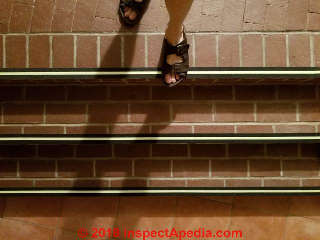 @Alejandro,
@Alejandro,
STAIR CODES & STANDARDS has the appropriate code PDF downloads.
But I don't think you'll find a detailed specification that addresses your question on step edge visibility as it's phrased in this discussion. Not in most states or provinces, but there are exceptions
California:
Interior stairs shall have the upper approach and lower tread marked by a stripe providing clear visual contrast. Exterior stairs shall have the upper approach and all treads marked by a stripe providing clear visual contrast.
The stripe shall be a minimum of 2 inches (51 mm) wide to a maximum of 4 inches (102 mm) wide placed parallel to, and not more than 1 inch (25 mm) from, the nose of the step or upper approach.
The stripe shall extend the full width of the step or upper approach and shall be of material that is at least as slip resistant as the other treads of the stair. A painted stripe shall be acceptable. Grooves shall not be used to satisfy this requirement.
See STAIR TREAD DIMENSIONS where I include and discuss the photo below
On 2021-07-28 by Alejandro
@inspectapedia.com.moderator, I see what you mean that they are more like landings instead of "stairs". I am sure a local building inspector approved them but would there be a IBC section or other standard that applies? Thanks!
On 2021-07-27 by inspectapedia.com.moderator (mod)
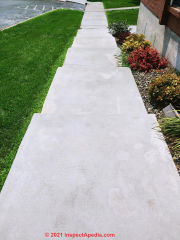 I speculate that if those steps have been approved by a local building inspector it is because they are long with multi strides, in essence a series of Landings and because there is no appreciable drop-off between the steps and the surrounding soil or grade.
I speculate that if those steps have been approved by a local building inspector it is because they are long with multi strides, in essence a series of Landings and because there is no appreciable drop-off between the steps and the surrounding soil or grade.
But I agree with you that lacking a visual clues of the edges of steps when all of the color is the same across steps and risers adds to the probability of a trip and fall.
I have seen some site managers address that problem by painting yellow or black and yellow stripes along the edges of each stair tread.
On 2021-07-27 2 by Alejandro
I ran across this stairway at a local hotel and it seemed to be unsafe without any railing or distinguishing of the steps. Would this stairway require one or more railings? Or some material so the steps can be separately discerned? Thanks!
On 2020-08-29 by (mod)
That's certainly a trip and fall hazard in your photo and I would expect a local building code compliance inspector to require a step that a reasonable height and also a landing or platform.
There are at least trip / fall hazards in your photo:
- tall step
- discontinuous or incomplete handrail
On 2020-08-29 by Jess
Does anyone know if it’s legal to have a huge step-over before the stairs to an apartment? Small hand railing is available but I’m also not sure that’s large enough for all the stairs. It doesn’t extend the entire way. (Picture attached)
On 2020-08-26 by (mod)
Angel:
A stair guard must be childproof which means that the balusters are 4 inches apart and are secure. If they can be easily moved aside it's unsafe - I would expect your local building inspector to agree.
Loose handrailings are unsafe and can contribute to a fall or injury;
We won't find every possible handrail installation snafu in the codes but the rail needs to be graspable and able to withstand specific force loads; In my OPINON a rail that comes loose or slides in its mounts is dangerous and would fail the load requirement; but the final legal authority is your local code inspector.
A complete set of CODES for STAIRS & RAILINGS as PDF downloads is at STAIR CODES & STANDARDS
On 2020-08-26 by Angel
We have questions about the staircase at The home we rent In Florida. Although the hand rail is fixed, the bars within the rail are not and easily come out. We have requested this to be fixed on multiple occasions as we have a small child.
Anyone know what the building requirements are, I’ve looked them up and cannot figure it out! Are the owners within code? Is this allowed by state building codes?
On 2020-07-20 - by (mod) -
John
The poor building code writers can't anticipate every crazy thing a person might do when building stairs. So you won't find an exact prohibition for the condition that you described but I agree that it is unsafe and improper.
Any astute Building Code Compliance inspector would simply say that the stairs failed to provide safe and adequate Headroom over all of the walking surface. It would make sense to install a free-standing railing to push Walkers away from the wall so they don't slice their heads open.
On 2020-07-18 by John Paiva
My daughter is renting a house. There are about 8 stairs leading up to the front door. On one side there is a handrail. On the other side, the stairs are attached to the house. The problem is that when someone walks up the stairs next to the house (opposite side to handrail) that person will walk right into the eves. I sliced my scalp open doing that. Even my little 3 foot tall nephew slammed his head into the eves. At the bottom of the stairs, the eves are not a problem but as you rise on the stairs, you will inevitable run into the eves and since most folks are looking DOWN when climbing stairs, the eve-hazard is not foreseen.
On 2020-06-17 - by (mod)
Ken
Or narrow stairs like that you only need a handrail on one side however you need a Guard railing on the section of the stairs that are open on one side so you might put your hand railing and guardrail all on the same side
On 2020-06-11 by Ken
I live in CT, have stairs to a basement that are on 28 inches wide (1950 vintage house). The stairs are open on one side for the last 7 steps. Do I need a railing on both sides?
On 2019-11-18 - by (mod) -
James
Limitations of continuity of handrailings along theatre seat rows
I've been looking at handrails and grabrails at the ends of rows of seats in theatres and concernt halls for a while now and see that the builders have to cope with conflicting objectives:
- provide something to hold on to arrest or avoid a fall
- avoid projecting rails that don't close on themselves so as to avoid hooking someone's clothes or bag strap
- at the same time, avoid narrowing the entry/exit to the aisle between rows of seats
- and yet preserve handrails along steps;
The usual compromise I see is a handrailing along a continuous wall - if there is one, but on the side of the steps along the ends of rows of seats, on cannot make a continuous handrail or people would have to crawl over or under it to get in to their seat.
I'd like to see a photo or two of the Honolulu aisle steps and rails and then might be able to comment further.
On 2019-11-18 by James Arcate
A Movie theatre in Honolulu has seats on both sides of the aisle steps. There are the inverted U shaped handrail with openings to seating on both sides of the aisle. There is no continuous handrail.
This is not safe. Is this legal?
On 2019-08-20 - by (mod) -
In many jurisdictions, yes, as a user walking anywhere but along the sides of that stair can easily be more than 3 ft. from a handrail
See details at https://inspectapedia.com/Stairs/Handrails.php HANDRAILS & HANDRAILINGS where we illustrate center and even multiple handrails on very wide stairways.
Quoting from that article
Ask your local inspector the maximum allowable stair width between rails. Typically it's 36" but they might let you get away with just 3 rails, one on either side and a center one leaving 4 ft wide stairways. The decision is local.
Stair width details are STAIR DIMENSIONS, WIDTH, HEIGHT https://inspectapedia.com/Stairs/Stair_Dimension_Specifications.php
On 2019-08-20 02:26:10.500906 by Corey
If you have a public set of stairs that measures 16ft wide all the way down. Are you required to have a handrail down the middle?
On 2019-04-02 - by (mod) -
Richard
Specifics on when a second handrail on the other side of a stairway is required vary by inspector, situation, and local codes but typically on a stair more than 36" wide you'll be asked to add the second handrail.
I agree that handrails reduce risk of fall injuries so on a stair with other safety hazards, more handrail is probably better.
On 2019-03-16 by richardd@theprogressivecompanies.com
Is there a code or standard that tells when or if you have to have handrails on both sides of a stair. Especially if the stair is steep.
On 2018-08-10 1 by Frank J. Oestreicher
What is the the railing height for a balcony or upper walkway inside a building that's 10' above floor
On 2017-11-01 by KS
Does exit stairs in retirement homes requires handrail on both sides at mid landings ? I understand that as long as guardrail in the middle should be continuous and 305mm projecting into the mid landing is a must so a person can keep his/her track. Please clarify
...
Continue reading at HANDRAIL GRASPABILITY CODES or select a topic from the closely-related articles below, or see the complete ARTICLE INDEX.
Or see these
Recommended Articles
- HANDRAILS & HANDRAILINGS - home
- FALL HAZARDS DUE TO UN-GRASPABLE HANDRAILS
- GRASPABILITY of HANDRAILINGS
- HANDRAIL CODES & OSHA HAND RAIL SPECS
- HANDRAIL CODES - GRASPABILITY
- HANDRAIL CONTINUITY
- HANDRAIL EXTENSION REQUIREMENTS
- HANDRAIL GRASPABILITY DEFECT PHOTOS
- HANDRAILING STRENGTH
- HANDRAILS for WIDE STAIRWAYS
- SNAG HAZARDS on STAIRWAYS
- RAILING CODES & STANDARDS - home
- STAIR CODES & STANDARDS - home
- STAIR CODE DETAILS
Suggested citation for this web page
HANDRAIL CODES & OSHA HAND RAIL SPECS at InspectApedia.com - online encyclopedia of building & environmental inspection, testing, diagnosis, repair, & problem prevention advice.
Or see this
INDEX to RELATED ARTICLES: ARTICLE INDEX to STAIRS RAILINGS LANDINGS RAMPS
Or use the SEARCH BOX found below to Ask a Question or Search InspectApedia
Ask a Question or Search InspectApedia
Try the search box just below, or if you prefer, post a question or comment in the Comments box below and we will respond promptly.
Search the InspectApedia website
Note: appearance of your Comment below may be delayed: if your comment contains an image, photograph, web link, or text that looks to the software as if it might be a web link, your posting will appear after it has been approved by a moderator. Apologies for the delay.
Only one image can be added per comment but you can post as many comments, and therefore images, as you like.
You will not receive a notification when a response to your question has been posted.
Please bookmark this page to make it easy for you to check back for our response.
IF above you see "Comment Form is loading comments..." then COMMENT BOX - countable.ca / bawkbox.com IS NOT WORKING.
In any case you are welcome to send an email directly to us at InspectApedia.com at editor@inspectApedia.com
We'll reply to you directly. Please help us help you by noting, in your email, the URL of the InspectApedia page where you wanted to comment.
Citations & References
In addition to any citations in the article above, a full list is available on request.
- Eric Galow, Galow Homes, Lagrangeville, NY. Mr. Galow can be reached by email: ericgalow@gmail.com or by telephone: 914-474-6613. Mr. Galow specializes in residential construction including both new homes and repairs, renovations, and additions.
- Thanks to reader Craig Sharp who contributed technical review & clarifications regarding the distinctions among handrailing, stair rail and guardrail 2/1/2-13.
- [1] Yale University Guidelines for Undergraduate Theatrical Productions and Special Events, Yale University’s Office of Undergraduate Productions, Office of the Fire Marshal, and Office of Environmental Health & Safety April 2005, web search 8/9/11, original source: http://www.yale.edu/oup/forms/pdf/guidelines.pdf
- [2] CUE40303 Certificate IV in Live Production, Theatre and Events (Technical Operations), Australian Government, Department of Education, Employment, and Workplace Relations, web search 8/9/11, original source: https://www.training.nsw.gov.au/cib_vto/cibs/documents/cue40303.pdf
- [3] Electrical Safety in the Theatre, Broadway Press, web search 8/9/11, original source: http://www.broadwaypress.com/PDFs/LTSpdfs/LTSchpt13.pdf - quoting:
Referring to the NEC will provide the technician with details specifically related to the theatre and moreover, these regulations will
be better suited to the needs of the theatre. - [4] Illustrated theatre production guide, John Holloway, Focal Press, 2002, ISBN 0240804937, 9780240804934
- [5] How to Build Theater Stairs, an Illustrated Guide, Ben Teague, www.benteague.com, Amateur Theatre Division, December 2004, web search 8/9/11, original source: http://www.benteague.com/features/Stairs.pdf
Note that Mr. Teague warns that his designs and advice do not comply with building codes. - [6] OSHA Publication 3124 - Stairways and Ladder, web search 12/21/11, OSHA Publications Office U.S. Department of Labor 200 Constitution Avenue, NW, N-3101 Washington, DC 20210 Telephone (202) 693-1888 or fax to (202) 693-2498. Original source: osha.gov/Publications/ladders/osha3124.html
- [7] Stephenson, Elliott O., THE ELIMINATION OF UNSAFE GUARDRAILS, A PROGRESS REPORT [PDF] Building Standards, March-April 1993
- [8] "Are Functional Handrails Within Our Grasp" Jake Pauls, Building Standards, January-February 1991
- [10] Lighting, proper use of: proper aiming of a good flashlight can disclose hard to see but toxic light or white mold colonies on walls.
- [11] The Stairway Manufacturers' Association, (877) 500-5759, provides a pictorial guide to the stair and railing portion of the International Residential Code. [copy on file as http://www.stairways.org/pdf/2006%20Stair%20IRC%20SCREEN.pdf ] -
[11a] "Visual Interpretation Of The International Residential Code (IRC) 2006 Stair Building Code", The Stairway Manufacturers Association, [Portions of this document reproduce sections from the 2006 International Residential Code, International Code Council, Falls Church, Virginia.},
The Stairway Manufacturers Association website stairways.org provides free downloads of stairway handrailing profiles and dimensions - [12] Slips, Trips, Missteps and Their Consequences, Gary M. Bakken, H. Harvey Cohen, Jon R. Abele, Alvin S. Hyde, Cindy A. LaRue, Lawyers and Judges Publishing; ISBN-10: 1933264012 ISBN-13: 978-1933264011
- [13] Steps and Stairways, Cleo Baldon & Ib Melchior, Rizzoli, 1989.
- [14] The Staircase, Ann Rinaldi
- [15] Common Sense Stairbuilding and Handrailing, Fred T. Hodgson
- [16] Falls and Related Injuries: Slips, Trips, Missteps, and Their Consequences, Lawyers & Judges Publishing, (June 2002), ISBN-10: 0913875430 ISBN-13: 978-0913875438
"Falls in the home and public places are the second leading cause of unintentional injury deaths in the United States, but are overlooked in most literature. This book is unique in that it is entirely devoted to falls. Of use to primary care physicians, nurses, insurance adjusters, architects, writers of building codes, attorneys, or anyone who cares for the elderly, this book will tell you how, why, and when people will likely fall, what most likely will be injured, and how such injuries come about. " - [17] Slips, Trips, Missteps and Their Consequences, Gary M. Bakken, H. Harvey Cohen, Jon R. Abele, Alvin S. Hyde, Cindy A. LaRue, Lawyers and Judges Publishing; ISBN-10: 1933264012 ISBN-13: 978-1933264011
- [18] Slips, Trips, Missteps and Their Consequences, Second Edition, Gary M. Bakken, H. Harvey Cohen,A. S. Hyde, Jon R. Abele, ISBN-13: 978-1-933264-01-1 or ISBN 10: 1-933264-01-2, available from the publisher, Lawyers ^ Judges Publishing Company,Inc., www.lawyersandjudges.com sales@lawyersandjudges.com
- [19] Arts, Crafts, & Theater Safety (ACTS), 181 Thompson Street, #23
New York, NY 10012-2586
Telephone: (212) 777-0062
E-Mail: ACTSNYC@cs.com, web search 5/9/12, website: http://www.artscraftstheatersafety.org/ - Quoting:
ACTS is a not-for-profit corporation that provides health, safety, industrial hygiene, technical services, and safety publications to the arts, crafts, museums, and theater communities. A part of the fees from our consulting services goes to support our free and low-cost services for artists. We gratefully accept donations, but do not solicit them from the artists who call here for help and advice. We recognize that artists and performers are among the least affluent groups in society.
ACTS also will not accept money or take advertising in our publications from manufacturers of artists materials or businesses whose interests could conflict with ours. We want artists to know that we have no financial incentive to make our product and safety recommendations. - [20] Access Ramp building codes:
- UBC 1003.3.4.3
- BOCA 1016.3
- ADA 4.8.2
- IBC 1010.2
- [21] Access Ramp Standards:
- ADA (Americans with Disabilities Act), Public Law 101-336. 7/26/90 is very often cited by other sources for good design of stairs and ramps etc. even where disabled individuals are not the design target.
- ANSI A117.4 Accessible and Usable buildings and Facilities (earlier version was incorporated into the ADA)
- ASTM F 1637, Standard Practice for Safe Walking Surfaces, (Similar to the above standard
- [22] The Circular Staircase, Mary Roberts Rinehart
- [23] Construction Drawings and Details, Rosemary Kilmer
- [24]"The Dimensions of Stairs", J. M. Fitch et al., Scientific American, October 1974.
- [25] Mobile Home Inspections common defects unique to factory built housing, inspection methods, The National Institute of Standards and Technology, NIST (nee National Bureau of Standards NBS) is a US government agency - see www.nist.gov
- [26] The Art of Staircases, Pilar Chueca
- [27 Building Stairs, by pros for pros, Andy Engel
- [28] A Simplified Guide to Custom Stairbuilding, George R. Christina
- [29] Basic Stairbuilding, Scott Schuttner
- [30] The Staircase (two volumes), John Templar, Cambridge: the MIT Press, 1992
- [31] The Staircase: History and Theories, John Templar, MIT Press 1995
- [32] Steps and Stairways, Cleo Baldon & Ib Melchior, Rizzoli, 1989.
- [33] BUILDING, FIRE, RESIDENTIAL CODES - The 2007 & 2010 California Building Code (Part 2), California Residential Code (Part 2.5) and the California Fire Code (Part 9) of Title 24 are available for viewing online via the following International Code Council web site link: California Codes, Title 24, Part 1, 6, 8, 10, 11 & 12 are also available for viewing and download in PDF form on the California website: 2007 Edition of the California Building Codes or see2010 Edition (Effective Jan. 1, 2011) of the California building codes. For a summary page accessing all of the California building codes see http://www.bsc.ca.gov/pubs/codeson.aspx
- [34] "Guard Rail Height", CREIA, California Real Estate Inspection Association, Website: http://ask.creia.org, web search 8/1/12 original source: http://ask.creia.org/index.php?topic=424.0, December 2009
- [35] California Department of Industrial Relations - CA/OSHA: California Stair & Railing Code details: Subchapter 7. General Industry Safety Orders, Group 1. General Physical Conditions and Structures Orders, Article 2. Standard Specifications, Section 3214. Stair Rails and Handrails, web search 8/1/12, original source: http://www.dir.ca.gov/title8/3214.html
- [36] California Department of Industrial Relations - CA/OSHA: California Stair & Railing Code details: Subchapter 4. General Industry Safety Orders, Article 17. Ramps, Runways, Stairwells, and Stairs, Section 1626. Stairwells and Stairs., web search 8/1/12, original source: http://www.dir.ca.gov/title8/1626.html
- [37] California Building Code, Nonstructural Design Requirements, web search 08/01/12 original source: http://sanbruno.ca.gov/comdev_images/California_Building_Code.pdf
- [38] Uniform Building Code Stair Specifications: UBC 1003.3.3.6 1997 or later specify handrail requirements, railing heights, rail widths, baluster spacing, stairway types, and guardrail specifications.
- Decks and Porches, the JLC Guide to, Best Practices for Outdoor Spaces, Steve Bliss (Editor), The Journal of Light Construction, Williston VT, 2010 ISBN 10: 1-928580-42-4, ISBN 13: 978-1-928580-42-3, available from Amazon.com
- In addition to citations & references found in this article, see the research citations given at the end of the related articles found at our suggested
CONTINUE READING or RECOMMENDED ARTICLES.
- Carson, Dunlop & Associates Ltd., 120 Carlton Street Suite 407, Toronto ON M5A 4K2. Tel: (416) 964-9415 1-800-268-7070 Email: info@carsondunlop.com. Alan Carson is a past president of ASHI, the American Society of Home Inspectors.
Thanks to Alan Carson and Bob Dunlop, for permission for InspectAPedia to use text excerpts from The HOME REFERENCE BOOK - the Encyclopedia of Homes and to use illustrations from The ILLUSTRATED HOME .
Carson Dunlop Associates provides extensive home inspection education and report writing material. In gratitude we provide links to tsome Carson Dunlop Associates products and services.




